Sourdough Pizza Dough Recipe (no yeast, best crust)
There’s something so satisfying about making homemade pizza, especially when it’s made from scratch. If you’re anything like me, you’ll love the simplicity of a recipe that doesn’t call for a long list of ingredients or complicated steps. All I want are a few wholesome ingredients and very little time investment to create a delicious mean. Is that really too much to ask? Thankfully, this sourdough pizza dough recipe (no yeast needed) ticks all those boxes.
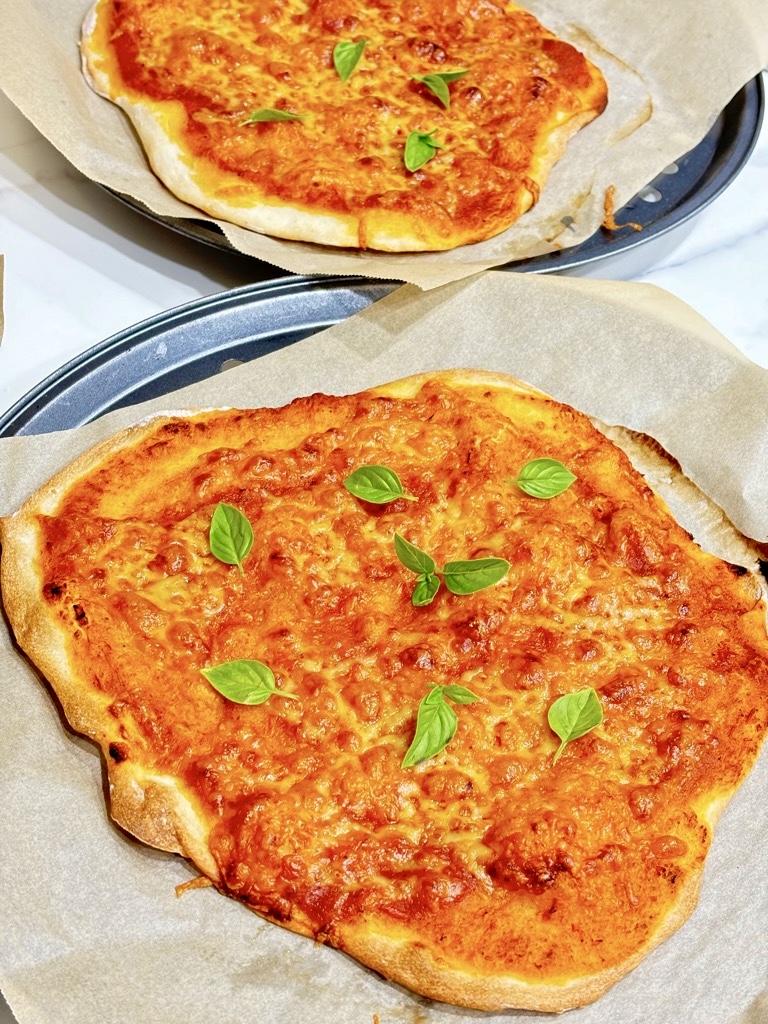
Not only is it a super easy recipe, but it’s also one that doesn’t require commercial yeast, which is perfect if you’ve been nurturing a sourdough starter or want to experiment with natural fermentation. Plus, there’s no better way to make Friday pizza nights at home feel extra special!
Now, let’s be honest – the idea of making pizza dough can be a bit intimidating, especially if you’re managing the busyness of life with little ones. But trust me, this recipe is simple and comes together easily while you’re sitting down for breakfast. I love that the sourdough gives this pizza dough a beautifully chewy texture with a hint of tanginess. You just can’t get that from regular or store-bought yeast dough. And the best part? You don’t need to be a sourdough expert. As long as you have an active starter, you’re ready to go!
If you’re new to sourdough baking, this recipe is a fantastic way to ease into it because it’s very forgiving. You can even prep the dough a day ahead, so there’s no pressure to get it all done at once. Just imagine the smell of freshly baked pizza filling your kitchen. It’s the kind of cozy, homemade meal that brings everyone around the table with big smiles.
So whether you’re planning a pizza night for family or friends or just want to indulge in a homemade meal for yourself, this sourdough pizza dough recipe (no yeast needed) will bring a rustic, authentic flavor to your kitchen. Let’s dive into how to make this delicious, wholesome meal.
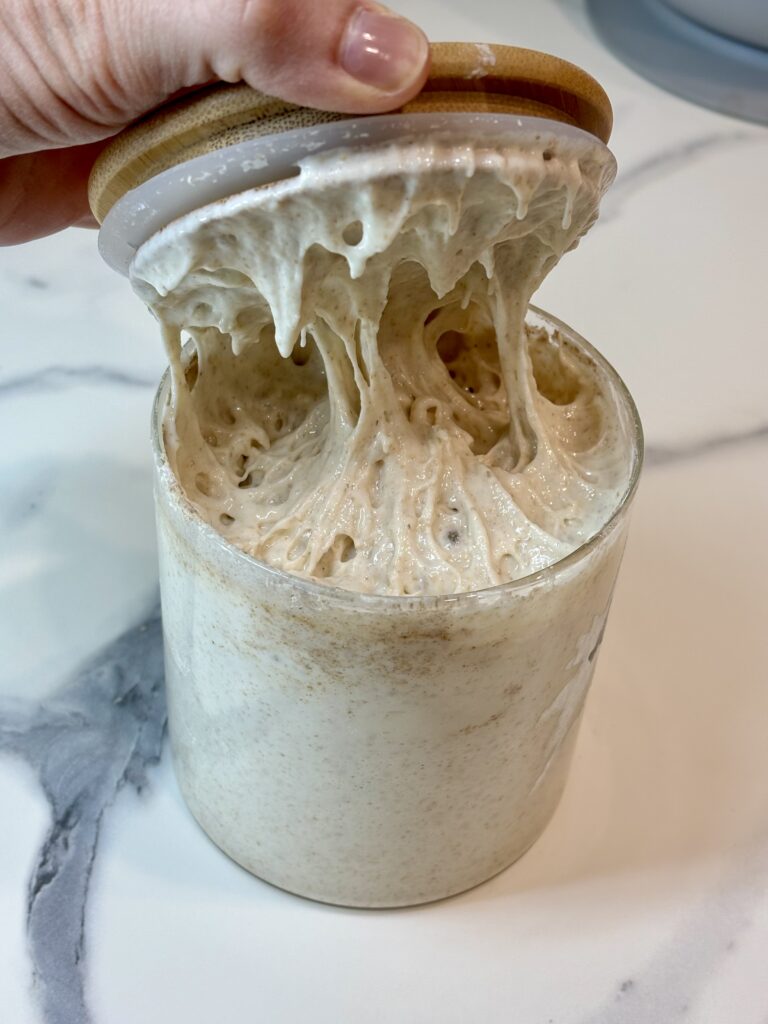
Ingredients
Active sourdough starter. Similar to other sourdough recipes, you want this one to be nice and bubbly. If you are planning to make sourdough pizzas for, let’s say, Wednesday’s dinner, feed your starter on Tuesday night to have it bubbly and ready to use by Wednesday morning.
Flour. You can make this recipe with all purpose flour, but pizza tastes even better when using strong bread flour.
Olive oil, because every Italian dish needs some.
Water, to bring everything together. Aim for warm water to help the dough rise faster. I find that cold water slows down the process, as it makes the dough itself cooler, which again causes the fermentation process to slow down.
Salt, for a little flavour.
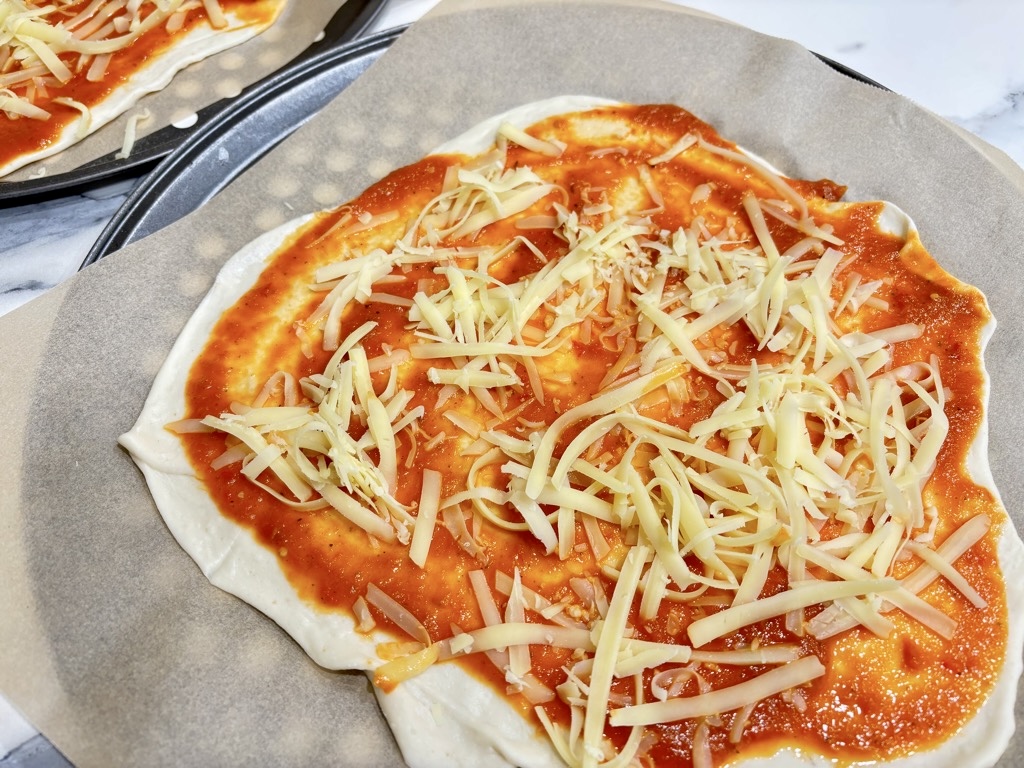
How to make this sourdough pizza dough recipe (no yeast)
Feed your starter. Start by feeding your starter the night before you want to serve this sourdough pizza dough recipe (no yeast) for dinner. We will need a super active and bubbly starter for this recipe, and feeding your starter the night before gives the dough enough time to rise during the day. Whether you want to only feed only enough to make up your needed quantity, or your whole jar of starter is entirely up to you. Disclaimer here that in warm regions, where sourdough starter discard becomes bubbly within hours of feeding it, a morning feed may be enough.
The next morning, your starter should be nice and active. It’s now time to mix our pizza dough ingredients.
In a large mixing bowl, combine the sourdough starter, flour, lukewarm water, olive oil and salt. You can start to bring these simple ingredients together using a wooden spoon, or can attach the bowl straight to your electric stand mixer.
Attach the dough hook attachment to your stand mixer and knead the dough on medium speed. We want the dough to be smooth and elastic and pass the windowpane test. Depending on your mixer, flour dough’s mood, this may take anywhere between 10 and 20 minutes.
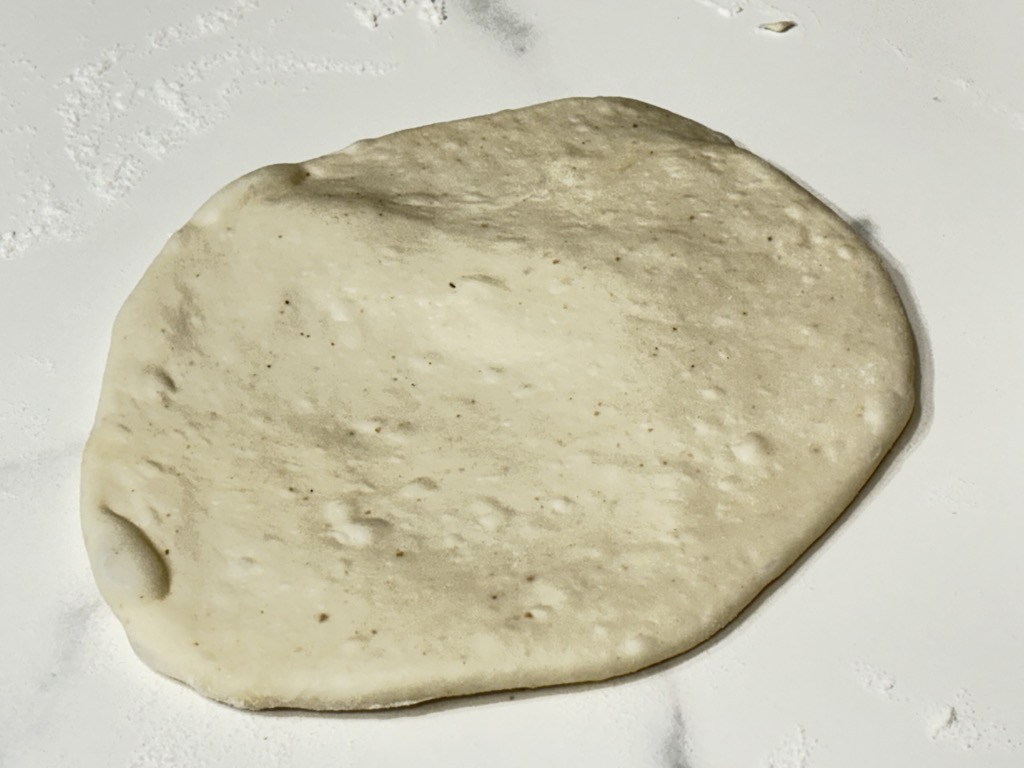
Rest and rise
Detach your bowl from the mixer and cover it with a clean tea towel. Allow the dough to rise at room temperature for about 4-6 hours. Your dough should double in size. If this timeframe feels too early for pizzas, move it to a slightly cooler place, like your pantry. You can otherwise let it rise at room temperature, and then move it into the fridge until closer to dinner time.
Shape and prepare. Once the dough has risen, preheat your oven to 220°C or 425°F. Take the dough out of the bowl and place it onto a lightly floured surface. Divide the dough into 2-3 equal portions and shape each into a dough ball.
Using a rolling pin, roll the dough balls into flat rounds. For thin-crust pizzas, roll the dough into flat discs. Alternatively, flatten the middle section of the rounds, but leave a nice, elevated crust to surround the pizza. Transfer the pizza crusts to baking sheets lined with parchment paper.
Top and bake. Use your favorite pizza toppings to cover the pizza base. Start by adding a (homemade) pizza sauce, and your favourite toppings. Cover everything with a little mozzarella cheese and bake the pizzas in the oven for 10-15 minutes or until the crust is crisp and golden.
Cut in slices and serve hot.
You can store leftovers in an airtight container in the fridge, or freeze individual slices wrapped in silver foil for next time pizza cravings come around.
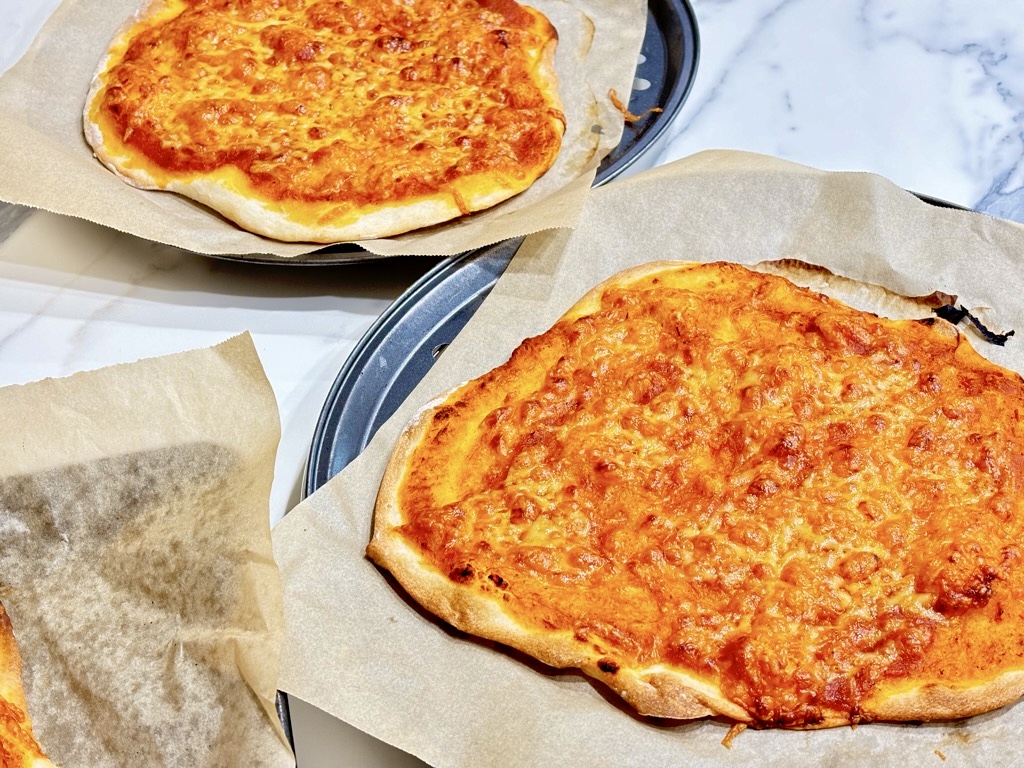
Why you’ll love this sourdough pizza dough recipe (no yeast needed)
No commercial yeast needed. This sourdough pizza dough recipe (no yeast) rises thanks to the power of sourdough starter.
Rustic flavour. Nothing is as rustic and wholesome as the delicious sourdough flavor. This sourdough pizza crust recipe makes even the most simple pizza taste like a slice of Italian heaven.
Easy and homemade. Just like sourdough bread, sourdough pizza recipes are incredibly easy to make. The key is in giving the dough ferment the time it needs. Thankfully, this fuss-free recipe can be whipped up during breakfast, and be ready to bake by dinner time.
Versatile. Whether you plan on having a family pizza night or cooking pizza for your next group even with friends, there’s no meal that allows the crowd to get as involved as fresh pizza. On your next pizza night, prepare a selection of your favorite toppings and let everyone decorate their own slice of heaven.
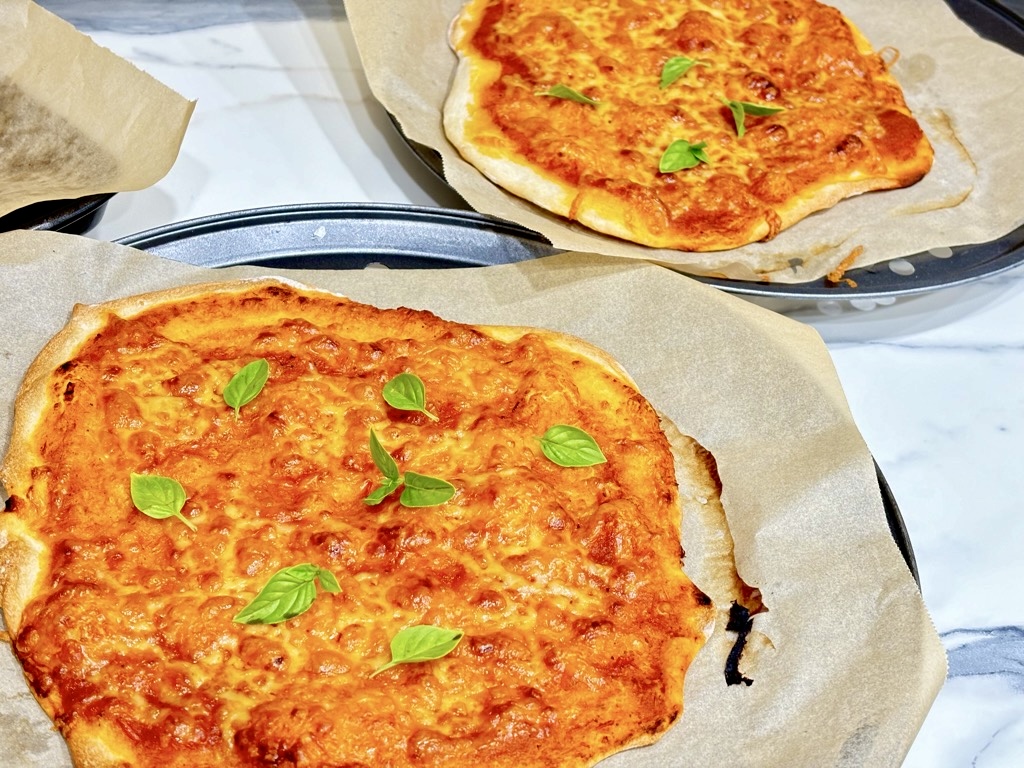
Other recipes to try
If you’ve enjoyed my sourdough pizzas, why not add something sweet for dessert? My stewed quinces are amazing over a bowl of fresh yoghurt, maybe even sprinkled with some crunchy granola. You could also try one of these recipes here:
Tips and Tricks
• Use an Active Starter: For the best results, make sure your sourdough starter is bubbly and active. Feed it early enough to give your sourdough pizza dough recipe (no yeast needed) time to rise.
• Room Temperature is Key: If your home is on the cooler side, the dough may take a bit longer to rise. Placing it in a warmer area (a sunny spot or on top of the fridge) can help speed things up. Similarly, if you want to slow things down, place the dough into a cooler spot during the fermentation process.
• Preheat Your Oven Properly: Letting the oven heat up fully is crucial for a crispy crust. I like to use pizza baking sheets with a piece of parchment paper, as the little holes in the sheet help my dough crisp up. A pizza stone can also help with even baking.
• Hydration Adjustments: For great results you’ll need great dough. If you find the pizza dough is too dry or too wet, don’t hesitate to adjust the water or flour by a tablespoon or so at a time until the texture feels right.
- Use flour to stop the dough from sticking: Roll the dough on a lightly floured work surface to prevent it from sticking to your kitchen bench or table.
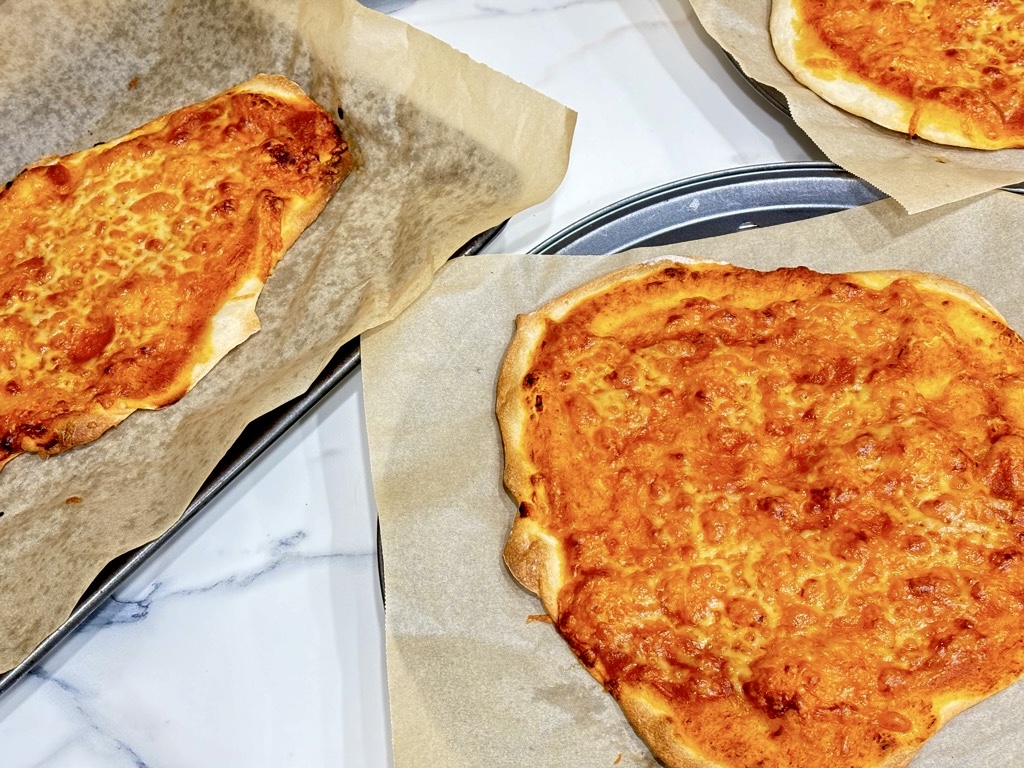
Easy Substitutes
• Flour: While all-purpose or bread flour is ideal, you can also experiment with spelt flour or whole wheat flour for a nuttier taste and chewier texture. Remember that heavier flours will need a little more liquid and may take longer in their bulk fermentation than white flour.
• Olive Oil: Olive oil gives the crust a bit of richness and helps with browning. You can substitute with melted butter or skip it entirely for a leaner dough.
• Sourdough Starter: If you’re not a sourdough baker, you can try a “wild yeast” starter made from just flour and water over a few days, though results may vary slightly. You could also use commercial yeast, which will make the dough rise faster. I personally prefer the flavour of a sourdough pizza crust.

Sourdough Pizza Dough Recipe (no yeast needed)
No better way to make Friday pizza nights at home feel extra special!
Ingredients
- 60g Sourdough starter
- 300g flour
- 180g water
- 1 Tsp salt
- 1 Tbsp salt
Instructions
- Feed your starter. Start by feeding your starter the night before you want to serve this sourdough pizza dough recipe (no yeast) for dinner. We will need a super active and bubbly starter for this recipe, and feeding your starter the night before gives the dough enough time to rise during the day. Whether you want to only feed only enough to make up your needed quantity, or your whole jar of starter is entirely up to you. Disclaimer here that in warm regions, where sourdough starter discard becomes bubbly within hours of feeding it, a morning feed may be enough.
The next morning, your starter should be nice and active. It's now time to mix our pizza dough ingredients. - In a large mixing bowl, combine the sourdough starter, flour, lukewarm water, olive oil and salt. You can start to bring these simple ingredients together using a wooden spoon, or can attach the bowl straight to your electric stand mixer.
- Attach the dough hook attachment to your stand mixer and knead the dough on medium speed. We want the dough to be smooth and elastic and pass the windowpane test. Depending on your mixer, flour dough's mood, this may take anywhere between 10 and 20 minutes.
- Rest and rise. Detach your bowl from the mixer and cover it with a clean tea towel. Allow the dough to rise at room temperature for about 4-6 hours. Your dough should double in size. If this timeframe feels too early for pizzas, move it to a slightly cooler place, like your pantry. You can otherwise let it rise at room temperature, and then move it into the fridge until closer to dinner time.
- Shape and prepare. Once the dough has risen, preheat your oven to 220°C or 425°F. Take the dough out of the bowl and place it onto a lightly floured surface. Divide the dough into 2-3 equal portions and shape each into a dough ball.
- Using a rolling pin, roll the dough balls into flat rounds. For thin-crust pizzas, roll the dough into flat discs. Alternatively, flatten the middle section of the rounds, but leave a nice, elevated crust to surround the pizza. Transfer the pizza crusts to baking sheets lined with parchment paper.
- Top and bake. Use your favorite pizza toppings to cover the pizza base. Start by adding a (homemade) pizza sauce, and your favourite toppings. Cover everything with a little mozzarella cheese and bake the pizzas in the oven for 10-15 minutes or until the crust is crisp and golden.
- Cut in slices and serve hot.
- You can store leftovers in an airtight container in the fridge, or freeze individual slices wrapped in silver foil for next time pizza cravings come around.
Notes
- Use an Active Starter: For the best results, make sure your sourdough starter is bubbly and active. Feed it early enough to give your sourdough pizza dough recipe (no yeast needed) time to rise.
- Room Temperature is Key: If your home is on the cooler side, the dough may take a bit longer to rise. Placing it in a warmer area (a sunny spot or on top of the fridge) can help speed things up. Similarly, if you want to slow things down, place the dough into a cooler spot during the fermentation process.
- Preheat Your Oven Properly: Letting the oven heat up fully is crucial for a crispy crust. I like to use pizza baking sheets with a piece of parchment paper, as the little holes in the sheet help my dough crisp up. A pizza stone can also help with even baking.
- Hydration Adjustments: For great results you'll need great dough. If you find the pizza dough is too dry or too wet, don’t hesitate to adjust the water or flour by a tablespoon or so at a time until the texture feels right.
- Use flour to stop the dough from sticking: Roll the dough on a lightly floured work surface to prevent it from sticking to your kitchen bench or table.
